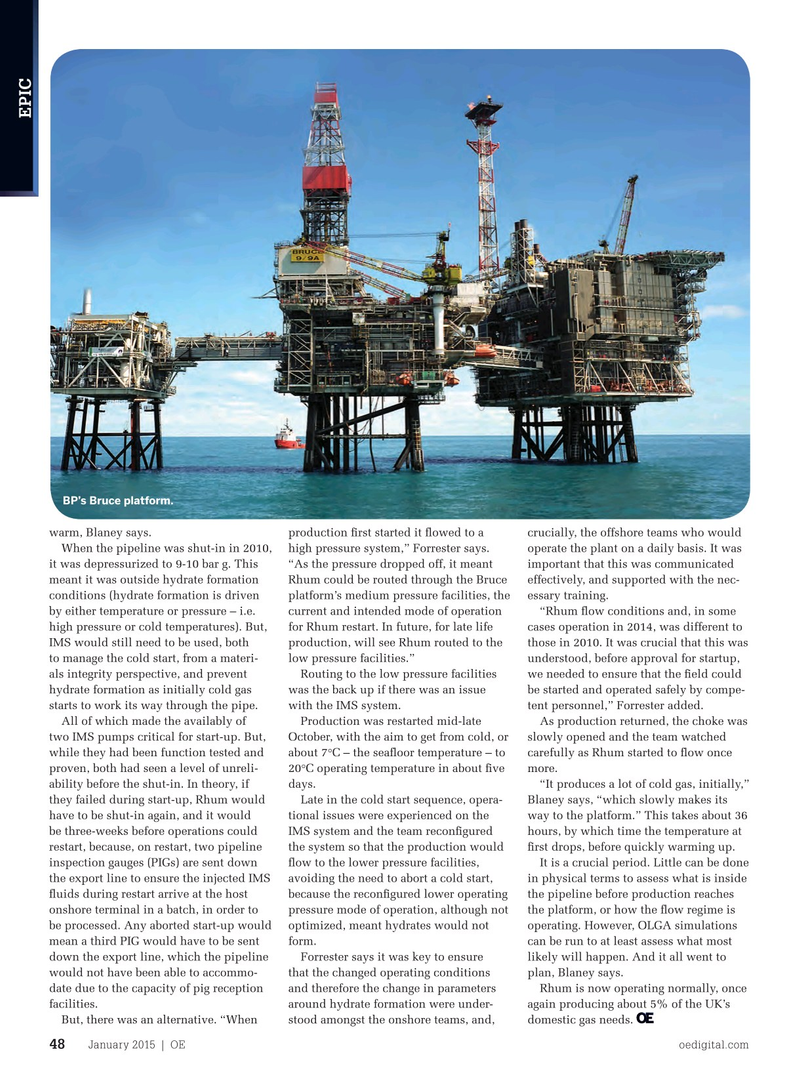
Page 46: of Offshore Engineer Magazine (Jan/Feb 2015)
Read this page in Pdf, Flash or Html5 edition of Jan/Feb 2015 Offshore Engineer Magazine
EPIC
BP’s Bruce platform.
warm, Blaney says. production frst started it fowed to a crucially, the offshore teams who would
When the pipeline was shut-in in 2010, high pressure system,” Forrester says. operate the plant on a daily basis. It was it was depressurized to 9-10 bar g. This “As the pressure dropped off, it meant important that this was communicated meant it was outside hydrate formation Rhum could be routed through the Bruce effectively, and supported with the nec- conditions (hydrate formation is driven platform’s medium pressure facilities, the essary training. by either temperature or pressure – i.e. current and intended mode of operation “Rhum fow conditions and, in some high pressure or cold temperatures). But, for Rhum restart. In future, for late life cases operation in 2014, was different to
IMS would still need to be used, both production, will see Rhum routed to the those in 2010. It was crucial that this was to manage the cold start, from a materi- low pressure facilities.” understood, before approval for startup, als integrity perspective, and prevent Routing to the low pressure facilities we needed to ensure that the feld could hydrate formation as initially cold gas was the back up if there was an issue be started and operated safely by compe- starts to work its way through the pipe. with the IMS system. tent personnel,” Forrester added.
All of which made the availably of Production was restarted mid-late As production returned, the choke was two IMS pumps critical for start-up. But, October, with the aim to get from cold, or slowly opened and the team watched while they had been function tested and about 7°C – the seafoor temperature – to carefully as Rhum started to fow once proven, both had seen a level of unreli- 20°C operating temperature in about fve more. ability before the shut-in. In theory, if days. “It produces a lot of cold gas, initially,” they failed during start-up, Rhum would Late in the cold start sequence, opera- Blaney says, “which slowly makes its have to be shut-in again, and it would tional issues were experienced on the way to the platform.” This takes about 36 be three-weeks before operations could IMS system and the team reconfgured hours, by which time the temperature at restart, because, on restart, two pipeline the system so that the production would frst drops, before quickly warming up. inspection gauges (PIGs) are sent down fow to the lower pressure facilities, It is a crucial period. Little can be done the export line to ensure the injected IMS avoiding the need to abort a cold start, in physical terms to assess what is inside fuids during restart arrive at the host because the reconfgured lower operating the pipeline before production reaches onshore terminal in a batch, in order to pressure mode of operation, although not the platform, or how the fow regime is be processed. Any aborted start-up would optimized, meant hydrates would not operating. However, OLGA simulations mean a third PIG would have to be sent form. can be run to at least assess what most down the export line, which the pipeline Forrester says it was key to ensure likely will happen. And it all went to would not have been able to accommo- that the changed operating conditions plan, Blaney says. date due to the capacity of pig reception and therefore the change in parameters Rhum is now operating normally, once facilities. around hydrate formation were under- again producing about 5% of the UK’s
But, there was an alternative. “When stood amongst the onshore teams, and, domestic gas needs.
January 2015 | OE oedigital.com 48 046_OE0115_EPIC1_Rhum.indd 48 12/22/14 6:55 PM

 45
45

 47
47